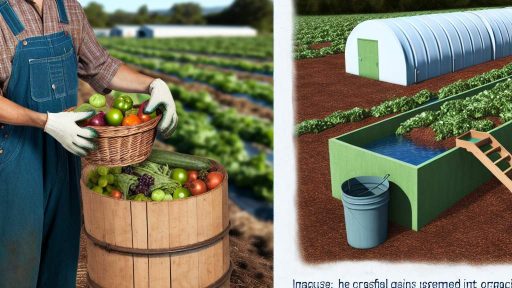Introduction to Farm-to-Restaurant Programs
Farm-to-restaurant programs create direct connections between farmers and local eateries.
These initiatives prioritize fresh, locally-sourced ingredients.
They significantly contribute to the local economy and community health.
Farmers benefit from stable market access through these programs.
Restaurants gain high-quality, seasonal produce for their menus.
Definition of Farm-to-Restaurant Programs
Farm-to-restaurant programs focus on sourcing food directly from local farmers.
This model encourages partnerships that promote sustainable agriculture.
Through these programs, chefs can create dishes that reflect local flavors.
Consumers also benefit from fresh and nutritious meal options.
Importance of Farm-to-Restaurant Programs
These programs support local economies by strengthening food systems.
They help reduce transportation costs and environmental impacts.
Farm-to-restaurant initiatives also foster community relationships.
They educate consumers about the origin of their food.
Furthermore, they encourage responsible farming practices.
Building Stronger Community Connections
Farm-to-restaurant programs cultivate collaborations within local communities.
Transform Your Agribusiness
Unlock your farm's potential with expert advice tailored to your needs. Get actionable steps that drive real results.
Get StartedFarmers gain valuable relationships with chefs and restaurant owners.
This cooperation can lead to innovative menu offerings.
It also helps build a sense of community pride around local agriculture.
Events such as farm tours and tasting dinners further enhance these connections.
Benefits for Local Farmers
Economic Impacts
Farm-to-restaurant programs boost local farmers’ income.
These initiatives create new market opportunities for fresh produce.
Moreover, they reduce transportation costs significantly.
Local restaurants often pay higher prices for fresh, quality ingredients.
This increased demand leads to more stable revenue sources.
Consequently, farmers can predict their income better each season.
Farm-to-restaurant partnerships foster direct sales.
This direct relationship enhances farmers’ bargaining power.
Additionally, it decreases dependency on middlemen.
As a result, farmers can plan their production around specific restaurant needs.
Social Impacts
These programs strengthen community ties.
Local farmers gain visibility within their communities.
Restaurants often highlight their local sourcing in their marketing.
This promotes an appreciation for fresh, local food among diners.
Furthermore, farm-to-restaurant collaborations educate consumers.
Community events introduce people to local farming practices.
Ultimately, this awareness fosters a healthier local food culture.
Farm-to-restaurant initiatives also create job opportunities.
As local demand increases, farmers may hire additional staff.
Consequently, this contributes to rural economic development.
Showcase Your Farming Business
Publish your professional farming services profile on our blog for a one-time fee of $200 and reach a dedicated audience of farmers and agribusiness owners.
Publish Your ProfileThe Role of Restaurants in Supporting Local Agriculture
Connecting Farmers with Foodies
Restaurants play a crucial role in connecting local farmers with consumers.
This connection promotes fresh produce and sustainable practices.
Moreover, it helps create a community around local food products.
Enhancing Menu Diversity
Incorporating local ingredients diversifies restaurant menus.
Chefs can create unique dishes that reflect seasonal offerings.
This approach keeps diners excited and returning for more.
Economic Support for Local Farmers
By purchasing from local farms, restaurants support the local economy.
This practice helps sustain smaller agricultural businesses.
In turn, it fosters a stable income for farmers in the region.
Reducing Environmental Impact
Farm-to-restaurant programs help minimize transportation emissions.
Using local ingredients significantly lowers the carbon footprint.
Consequently, this approach nurtures a more sustainable food system.
Building Relationships in the Community
Restaurants form essential partnerships with local farmers.
These relationships foster collaboration and trust within the community.
Additionally, events like farm dinners enhance community engagement.
Educating Consumers on Local Agriculture
Restaurants can educate diners about the benefits of local agriculture.
They can share stories of the farms they partner with.
Furthermore, featuring local ingredients raises awareness about food sources.
Promoting Seasonal Eating
Restaurants that focus on local sourcing encourage seasonal eating.
This practice aligns dining experiences with nature’s cycles.
As a result, it enhances flavor and nutrition in food offerings.
Uncover the Details: Integrating Permaculture Guilds To Boost More Resilient Farm-To-Table Crops
Challenges Faced by Farmers Participating in Farm-to-Restaurant Programs
Market Access Issues
Farmers often struggle with accessing local markets.
This issue arises from a lack of awareness among restaurants.
Many chefs prefer to source from established suppliers.
Consequently, smaller farms miss opportunities for partnerships.
Logistical Difficulties
Transportation can be a significant challenge for farmers.
Maintaining freshness during transit requires careful planning.
Additionally, coordination with restaurants can be complex.
Farmers often face strict delivery schedules.
As a result, meeting these demands can create stress.
Pricing and Economic Pressures
Setting competitive prices can be challenging for farmers.
They must balance costs with the prices set by restaurants.
Furthermore, fluctuations in market demand complicate pricing strategies.
Farmers also deal with fluctuating production costs throughout the year.
Quality and Food Safety Standards
Restaurants often require high-quality produce.
Farmers must adhere to specific food safety regulations.
This adherence demands time and resources that may be limited.
Additionally, maintaining consistent quality poses a challenge.
Relationship Building
Establishing strong relationships with restaurants is crucial.
Showcase Your Farming Business
Publish your professional farming services profile on our blog for a one-time fee of $200 and reach a dedicated audience of farmers and agribusiness owners.
Publish Your ProfileHowever, farmers may find this process daunting and time-consuming.
Communication gaps can lead to misunderstandings.
Trust takes time to build, thus requiring patience.
Furthermore, networking within the local food community can be intimidating.
Gain More Insights: Permaculture Practices for Reducing Farm Waste and Improving Yield
Successful Case Studies
Farm-to-Table Initiative in Blue Ridge
The Blue Ridge Farm-to-Table Initiative connects local farmers with restaurants in the region.
This program promotes seasonal menus that change based on farmers’ harvests.
Participating chefs collaborate directly with farmers to source fresh ingredients.
As a result, customer interest in locally-sourced dishes has significantly increased.
Restaurants have reported higher sales and customer satisfaction since joining the initiative.
Sustainable Harvest Project
The Sustainable Harvest Project operates in the Pacific Northwest, focusing on sustainability.
This initiative works closely with small organic farms to supply local eateries.
Participating restaurants commit to featuring local produce on their menus.
Consequently, they strengthen community ties and support the local economy.
Farmers gain a reliable market for their products, ensuring fair prices and steady income.
Farm Fresh Direct
Farm Fresh Direct serves as a wholesale distributor connecting local farms and restaurants.
It streamlines the supply chain, making local produce more accessible.
This program is beneficial for smaller restaurants that often struggle with sourcing.
It also helps showcase regional specialties to a broader audience.
Participating farms appreciate the consistency and support from local chefs.
Harvests of Hope Program
Harvests of Hope focuses on reducing food waste while supporting local farmers.
This program partners with restaurants to donate unused food to community organizations.
It promotes environmentally sustainable practices while helping those in need.
Moreover, this initiative helps restaurants foster community goodwill.
Farmers feel empowered knowing their products contribute to meaningful initiatives.
Chef’s Choice Local Farm Collaborations
Chef’s Choice fosters direct partnerships between renowned chefs and local farmers.
Culinary professionals develop exclusive dishes that highlight seasonal ingredients.
This partnership enhances restaurant menus and elevates local produce visibility.
Chefs often host farm tours to educate the public about local food sourcing.
This initiative encourages diners to appreciate farm-fresh ingredients.
Learn More: Food Origin Tracking and Its Importance for Sustainable Farming

How to Start a Farm-to-Restaurant Program
Understanding the Benefits
Farm-to-restaurant programs provide numerous advantages for farmers and chefs.
Firstly, they foster community connections.
Moreover, these programs enhance food quality and freshness.
Additionally, they support local economies through increased sales.
Building Collaborative Relationships
Start by identifying local restaurants that prioritize fresh ingredients.
Reach out to chefs who value sourcing locally.
Schedule meetings to discuss potential partnerships.
During these meetings, share your farm’s story and products.
Establish mutual goals for the partnership.
Showcase Your Farming Business
Publish your professional farming services profile on our blog for a one-time fee of $200 and reach a dedicated audience of farmers and agribusiness owners.
Publish Your ProfileCreating a Product List
Compile a list of products you can supply to restaurants.
Include seasonal offerings to appeal to chefs.
Be transparent about availability to enhance trust.
Consider packaging options that align with restaurant needs.
Setting Pricing Structures
Determine fair pricing for your products based on costs and market value.
Discuss pricing openly with chefs to reach an agreement.
Be flexible to negotiate terms that benefit both parties.
Establishing Delivery Methods
Plan delivery schedules that align with restaurant operations.
Consider logistics for transporting fresh produce safely.
Communicate regularly about delivery status to maintain trust.
Promoting Your Partnership
Effectively market your farm-to-restaurant collaboration.
Utilize social media to share updates and farm stories.
Encourage the restaurant to promote your products as well.
Host events that showcase meals made from your produce.
Continuously Evaluating the Program
Regularly assess the effectiveness of the partnership.
Gather feedback from chefs about product quality and service.
Be open to making changes based on feedback received.
Maintain an ongoing dialogue to strengthen the relationship.
Delve into the Subject: Organic Crop Rotation Strategies for Soil Health
Building Relationships: Communication Strategies Between Farmers and Restaurants
The Importance of Communication
Effective communication fosters strong relationships between farmers and restaurants.
It enhances trust and mutual understanding.
Additionally, clear communication ensures transparency in sourcing.
Regular Meetings and Check-Ins
Establishing regular meetings is essential for relationship-building.
These meetings provide opportunities to discuss seasonal changes.
Farmers can share insights on crop availability and quality.
Restaurants can provide feedback on customer preferences.
Utilizing Technology
Technology can greatly enhance communication efforts.
Messaging apps make it easier to share updates and photos.
Social media platforms can showcase seasonal offerings.
Furthermore, dedicated platforms can streamline order management.
Creating a Feedback Loop
Encouraging feedback strengthens collaboration.
Farmers should ask restaurants how their products perform.
Restaurants can inquire about farmers’ growing practices.
This two-way communication fosters continuous improvement.
Participating in Local Events
Engaging in community events builds awareness and relationships.
Farmers can showcase their produce at restaurant openings.
Restaurants can host farm visits for staff and customers.
Such interactions create shared experiences and foster loyalty.
Establishing Partnership Agreements
Formal partnership agreements can clarify expectations.
These agreements outline delivery schedules and pricing.
Showcase Your Farming Business
Publish your professional farming services profile on our blog for a one-time fee of $200 and reach a dedicated audience of farmers and agribusiness owners.
Publish Your ProfileMoreover, they can specify product quality standards.
Clear agreements reduce misunderstandings and disputes.
The Future of Farm-to-Restaurant Programs: Trends and Innovations
Embracing Technology
Farm-to-restaurant programs increasingly utilize technology for efficiency.
Farmers use apps to track supply and demand.
This enhances communication between producers and chefs.
Additionally, restaurants can utilize digital platforms for ordering.
These innovations streamline the procurement process significantly.
Sustainable Practices
More restaurants are prioritizing sustainable sourcing methods.
They choose local produce to reduce carbon footprints.
This trend supports local economies while promoting fresh ingredients.
Moreover, sustainable practices attract environmentally conscious consumers.
Collaborative Initiatives
Partnerships between farmers and restaurants are on the rise.
Many chefs collaborate directly with local producers.
These relationships foster creativity and unique menu offerings.
Furthermore, joint marketing initiatives promote the partnership.
This not only increases visibility but also strengthens community ties.
Consumer Demand for Transparency
Today’s diners crave transparency about their food sources.
They seek information on where their meals originate.
Farm-to-restaurant programs address these consumer preferences.
Restaurants often display sourcing information on menus.
This increases consumer trust and loyalty.
Innovation in Food Preservation
Innovative preservation techniques are becoming more popular.
Canning, pickling, and fermenting help extend the seasons.
These methods allow restaurants to serve local produce year-round.
Additionally, they add unique flavors to seasonal menus.
Educational Opportunities
Farm-to-restaurant programs are enhancing educational initiatives.
Workshops and farm tours educate chefs and diners alike.
Participants learn about sustainable agriculture practices.
These educational experiences encourage deeper connections with food.
Moreover, they foster community involvement and support.




